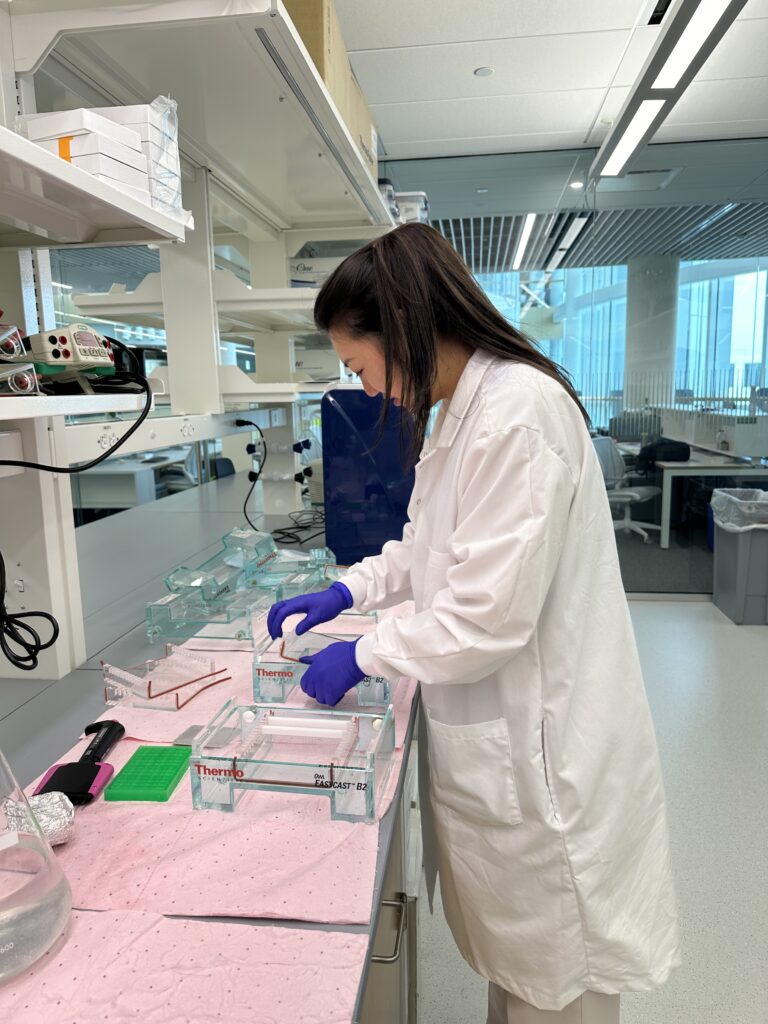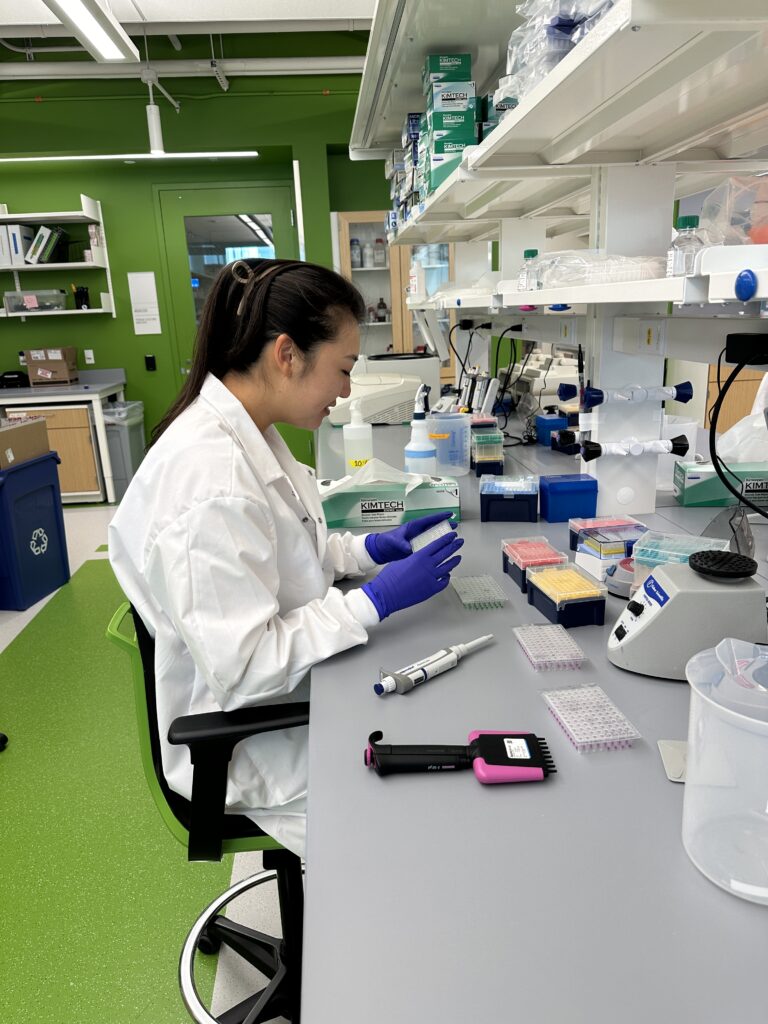Kim discusses her journey to the Ragon Institute and her aspirations for the future
Exchange programs and global collaboration play a vital role in advancing scientific research, allowing researchers to share knowledge, resources, and expertise across borders — a philosophy the Ragon Institute is deeply committed to.
For Youry Kim, PhD, the Ragon offered an ideal opportunity to advance her research and professional growth. An exchange fellow from the Peter Doherty Institute for Infection and Immunity (Doherty Institute) in Melbourne, Australia, Kim joined the Ragon Institute this summer for a four-month stay working in the lab of Ragon faculty member Mathias Lichterfeld, MD, PhD, and often collaborating with another Ragon faculty member, Xu Yu, MD.
During her fellowship, Kim has aimed to deepen her understanding of HIV cure research, particularly focusing on innovative strategies to eliminate latent HIV reservoirs — groups of immune system cells that are infected with HIV but are not actively producing new HIV particles.
Her journey, from her extensive experience in Australia to her current work at the Ragon Institute, has only reinforced her commitment to advancing scientific knowledge and improving global health.
We spoke to Kim to learn more about her background, her research journey, and her experiences at the Ragon Institute over the past few months:
Could you tell me a little bit about your background, who you are, and what you were doing before you came to the Ragon Institute?

My name is Youry Kim. I’m a postdoctoral research fellow at the Doherty Institute in Melbourne, Australia. I started back in 2014 in the lab of Prof. Sharon Lewin, Director of the Doherty Institute. I did my honors with her, which is a degree that the US doesn’t have. It’s like doing a master’s in one year, where you complete a project and write a thesis. One of the requirements for doing a PhD in Australia is completing an honors year, so I did that and then stayed on to do my PhD in HIV cure research. I finished my PhD in 2019 and stayed with Sharon to finish up my projects. Then COVID hit, limiting job options. I got offered a position with a different professor at the Doherty Institute working on SARS-CoV-2, focusing on vaccine candidates for a year. Despite learning a tremendous amount during my first year as a postdoc,I wanted to return to HIV cure research, which is a passion of mine, so I rejoined Sharon’s lab. I’ve been with her for nine years now, and I’m in my third year as a postdoc.
Could you tell me more about the Doherty Institute and what it is specifically?
Much like the Ragon Institute, the Doherty Institute is a joint-venture between the University of Melbourne and the Royal Melbourne Hospital, a leading biomedical hub combining research, teaching, public health and reference laboratory services, diagnostic services and clinical care in infection and immunity. It brings together top scientists and clinicians who collaborate to improve health globally through discovery research and the prevention, treatment and cure of infectious diseases. It is home to two prominent public health laboratories including the Victorian Infectious Diseases Reference Laboratory (VIDRL), which was the first to grow SARS-CoV-2 outside China and shared the isolate globally. The Doherty Institute houses six WHO Regional Reference Laboratories, including one of five WHO Collaborative Centres for Reference and Research on Influenza in the world..
When I started, there were around 700-800 people in the Institute, and this number has increased since due to expansion during the COVID-19 pandemic. We now have the Cumming Global Centre for Pandemic Therapeutics, a new initiative enabling the rapid design and development of therapeutics for future pandemics. Recently, the Doherty Institute also launched Doherty Clinical Trials, Australia’s first clinical trial facility specifically commissioned to deliver human challenge trials.. Additionally, together with Burnet Institute and the University of Melbourne, with support from the Victorian government, the Doherty Institute is establishing the Australian Institute of Infectious Diseases, a state-of-the-art facility supporting research into life-saving therapeutics, diagnostics and vaccines to protect against infectious diseases and future pandemics. This new Institute is part of our future expansion.
Could you describe how you came over to the Ragon Institute? What were the circumstances that led to that?

In February 2023, our weekly newsletter at the Doherty Institute advertised a collaborative fellowship between the Doherty Institute and the Ragon Institute. The fellowship involved coming to the Ragon for a specified period for scientific exchange and bringing this knowledge and techniques back to the Doherty Institute. When I saw it, I thought it was a great opportunity. One of the requirements was to develop your own project with a PI at the Ragon who had to agree to take you. I reached out to Mathias Lichterfeld, whom I knew from an NIH collaborative called DARE (Delaney AIDS Research Enterprise). Mathias is renowned for his techniques to better understand the epigenetic characteristics of integrated HIV, and this drew me into working and learning in his lab. I applied in February, and by May or June, I was told I received the fellowship. The visa process took a while, so I planned to come the following year, aligning with my project timelines in Melbourne. Mathias was flexible with my start date and we arranged it based on our project needs.
Could you describe your research?
I work on HIV cure research. There’s no current cure for HIV because the virus can hide in cells and remain dormant, making it hard to differentiate infected cells from non-infected ones. Current antiretroviral therapies prevent new infections but they don’t stop dormant cells from reactivating, which can cause issues. My research focuses on novel drugs that reactivate these dormant cells and lead to their death, aiming to clear any remaining HIV in the body. I work on a strategy called “Shock and Kill,” testing drugs that can both shock the dormant cells and kill them. Here at the Ragon Institute, I’m investigating a new type of drug called a SMAC mimetic that has the potential to both shock and kill through different pathways. I’m studying whether this drug reduces the population of latent HIV cells and the mechanisms behind it, including the virus’ integration into the human genome, and whether the location of the viral integration contributes to the effects of these drugs on the infected cells.
What has it been like working in the Lichterfeld Lab?
It is a very familiar feeling. I’ve been a researcher for ten years, so the lab environment is similar, with everyone having their own projects, including technicians, postdocs, and PIs. It is also similar to my lab back in Melbourne in that everyone is very collaborative within the lab group and ideas are shared and explored both in the lab and outside. The research conducted here is also of a very high quality and everyone is so friendly and inclusive, even outside of work activities. Overall, it’s been a really good experience for me.
What’s next for you after the end of this project or your stay here?
I’ll be going back to Australia to effectively try and set up everything that I’ve learned here in Melbourne. The Doherty Institute and HIV research in Melbourne will greatly benefit from the assays and techniques I have learnt here, and we’ll maintain an open collaboration with Matthias and his team. They have the bioinformatics expertise, which complements our work. So it will be about conducting similar high-quality research in Australia, which I’m looking forward to.
Is there anything I didn’t ask you about that you think would be worth mentioning?
More people should be aware of this fellowship, which is funded by my state government and is open to Ragon people to come to Australia as well. So it’s definitely a two-way opportunity and I would encourage anyone interested to look into it.
Learn more about the Ragon Doherty Fellowship here.


 Ragon Institute
Ragon Institute 